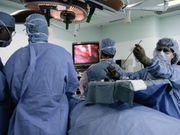Image noise reduction algorithm reduces radiation exposure during coronary angiography, angioplasty
THURSDAY, July 21, 2016 (HealthDay News) — For patients undergoing coronary angiography and coronary angioplasty, a new X-ray technology with an image noise reduction algorithm reduces radiation exposure, according to research published in the Aug. 1 issue of The American Journal of Cardiology.
Mirlind Kastrati, M.D., from Bonifatius Hospital Lingen in Germany, and colleagues evaluated the reduction of radiation dose in coronary angiography and angioplasty with use of image noise reduction technology. Radiation dose data were obtained for 605 consecutive coronary procedures (397 coronary angiograms and 208 coronary interventions) performed on a coronary angiography system with noise reduction technology from October 2014 to April 2015. Data were also collected from 695 consecutive coronary procedures (435 coronary angiograms and 260 coronary interventions) performed on a conventional coronary angiography system from October 2013 to April 2014. There was no change in operators or operator practice in the two time periods.
The researchers observed no significant between-group differences in gender, age, weight, and fluoroscopy time. Using the new noise reduction technology, there were significant reductions in the dose area product in coronary angiograms and coronary interventions (both P < 0.001). Similar image quality was seen between the evaluated systems.
“In conclusion, a new X-ray technology with image noise reduction algorithm provides a substantial reduction in radiation exposure without the need to prolong the procedure or fluoroscopy time,” the authors write.
Copyright © 2016 HealthDay. All rights reserved.








